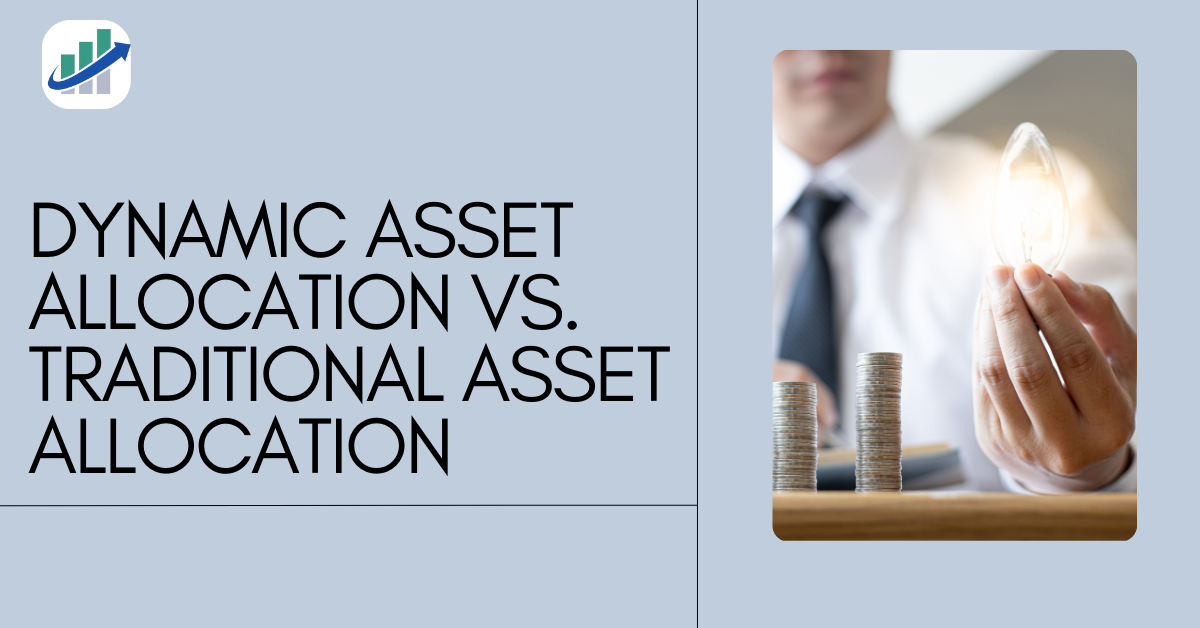Investing in the financial market can feel overwhelming because there are so many choices. One big decision investors have to make is how to divide their money among different types of investments.
There are two main ways to do this: dynamic asset allocation and traditional asset allocation.
Dynamic Asset Allocation Fund means regularly changing how you divide your money based on what’s happening in the market. For example, if stocks are doing well, you might put more money into them, and if bonds are doing poorly, you might take money out.
This approach can help you take advantage of good opportunities, but it also involves more risk because you have to keep an eye on the market all the time.
Traditional asset allocation is more straightforward. You decide on a plan for how to divide your money based on your goals and how much risk you’re comfortable with.
Then you stick to that plan over time, only making small changes now and then to keep things balanced.
This method is more stable and less risky, but you might miss out on some chances to make more money when the market is up.
Both approaches have their pros and cons, so it’s important to think about what’s best for you before you decide.
If you like keeping an eye on the market and are willing to take some risks for the chance of making more money, a dynamic asset scheme might be a good fit.
But if you prefer a more steady and predictable approach, traditional asset allocation might be better.
Dynamic vs. Traditional Asset Allocation
A dynamic asset mutual fund adjusts the portfolio mix in response to changing economic and market conditions for optimal performance.
Actively rebalancing across stocks, bonds, real estate, and commodities, aims to capture opportunities and reduce risk.
Mutual fund managers are also using a dynamic allocation strategy in their funds called dynamic asset fund or balanced advantage fund
Traditional asset allocation
On the other hand, traditional asset allocation adopts a more static or buy-and-hold approach.
It involves choosing a stable asset allocation that aligns with an investor’s risk tolerance, goals, and long-term time horizon.
Periodically, the portfolio actively undergoes rebalancing to realign it with the initial allocation.
Dynamic asset allocation compared to traditional asset allocation strategies
Risk tolerance
Opt for traditional asset allocation if you have a lower risk tolerance and prefer a more hands-off approach.
It can assist you in maintaining your investments through market downturns without acting rapidly.
Time Commitment
Due to its active management style, dynamic asset schemes require more time and effort.
Dynamic allocation may be suitable if you are willing to regularly analyze your investments and stay updated with market trends.
Investment Goals
Dynamic asset allocation aligns with specific short-term objectives or higher returns goals to achieving financial targets.
Knowledge and Expertise
Evaluate your knowledge and experience in investments.
A solid understanding of financial markets and economic data is necessary for dynamic asset funds. A conventional strategy may be safer if you lack the skills or confidence to actively manage your investments.
Diversification
No matter which strategy you decide to choose, diversification is still a crucial element of successful investment.
Diversification across various asset classes can be beneficial for both dynamic and conventional asset allocation techniques.
Dynamic asset allocation strategies-
Sector Rotation
A specific kind of dynamic asset mutual fund method called sector rotation focuses on redistributing investment among various stock market sectors or industries.
Sector rotation aims to invest in sectors outperforming while avoiding underperforming ones, capitalizing on changing economic conditions and business cycle
Rebalancing
To maintain the intended asset allocation, rebalancing changes the composition of the portfolio.
This approach actively maintains the portfolio in alignment with the investor’s risk appetite, investment objectives, and time horizon.
Investors invest in a dynamic asset allocation strategy and a financial manager sets a target allocation of 60% of equity and 40% of bonds.
The stock market performs well over time, increasing the equity component of the portfolio to 70%.
Then the manager must rebalance the portfolio by selling some shares and buying fixed-income assets to retain the correct allocation.
By doing this, the portfolio actively recovers its intended mix of 60% stocks and 40% bond securities.
Rebalancing is vital in balanced advantage fund ensuring the portfolio aligns with objectives and risk tolerance in a volatile market.
Risk Parity
In order to avoid investing the same amount of money in each investment, dynamic risk parity is a clever technique to diversify your investments across a variety of assets (such as stocks, bonds, and more).
Instead, it changes how much you invest in each object depending on how dangerous or safe they are at the moment.
This dynamic allocation technique constructs the portfolio with a focus on risk rather than asset classes.
It distributes risk among several asset classes.
If stocks were expected to carry higher risk than bonds, the allocation to stocks would be reduced to balance the portfolio’s overall risk.
In other words, assets with more risk have lower budget allocations, whereas assets with lesser risk have higher allocations.
Dynamic Risk Management
On the basis of variation in market volatility, it modifies the portfolio mix.
Investors can manage risk with the aid of this tactic, which can also reduce the portfolio’s exposure to market volatility.
This approach may assist investors in minimizing downside risk and maximizing returns.
For example- The allocation to fixed-income instruments like bonds, which are normally less volatile than equities, if market volatility is high.
In contrast, if market volatility is minimal an increase in their allocation to stocks, normally gives higher returns than fixed-income securities.
Conclusion
Two different methods of managing investment exist: dynamic asset Fund and traditional asset allocation.
The best option will depend on your unique situation and preferences. Consider SIP in mutual fund for investing which will provide you better income option.
Evaluate your risk tolerance, investing goals, time commitment, and experience before selecting an approach to meet financial goals effectively.
Consult a financial advisor for tailored guidance to make informed and significant investment decisions based on your unique circumstances.



